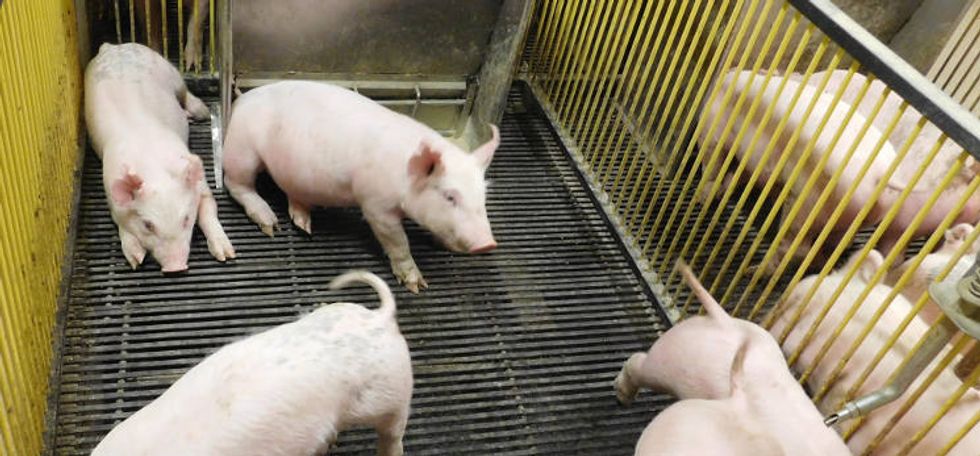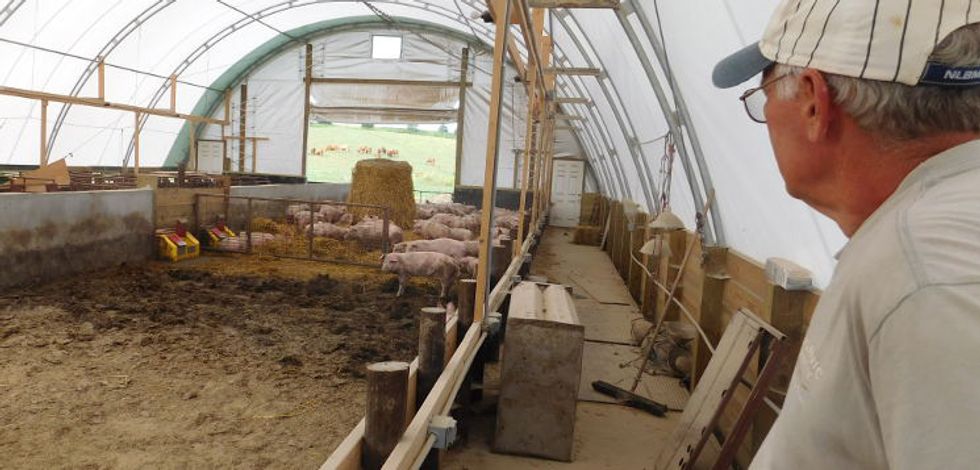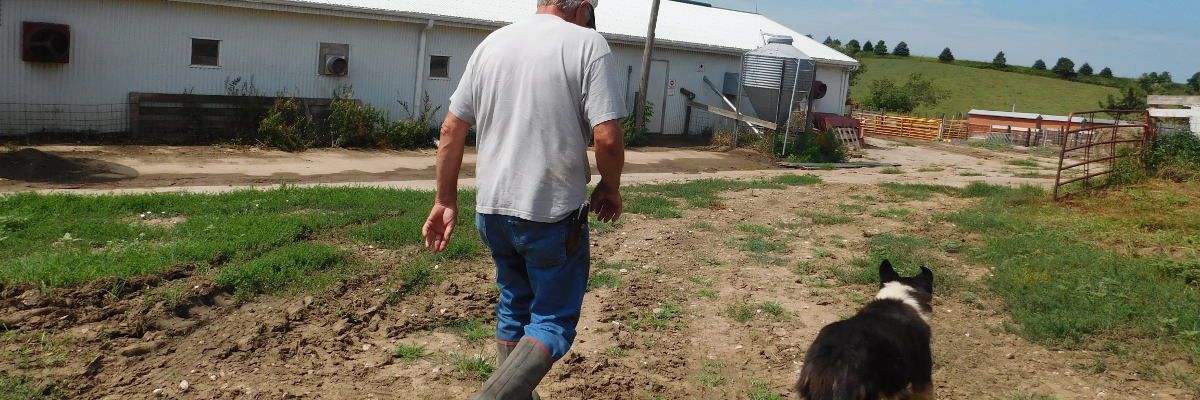HARLAN, Iowa—Over a lunch of burgers and pork tacos, Ron Rosmann talks about everything from bluegrass music to one of his favorite authors, Mari Sandoz.
But when the topic turns to hobbies, his son interjects: "Your only hobby was farming."
Rosmann, smiles, wipes his mouth. "That's true."
His 700-acre farm is much more than hobby—growing organic oats, beans, turnips, hay, and raising about 90 cows and hundreds of organic hogs annually. Rosmann has dedicated his life to environmentally friendly, family farming.
Back at the farm he gives me the tour with barn kittens following us around.
He has a large hoop structure to contain the pigs, a type that's gaining popularity among outdoor hog raisers. The kittens scare some young piglets as we talk organic feed and watch a sow root around a bit, flop her body down, kick around a couple times and seemingly smile once properly muddy.
Of course I can't confirm the smile. But Rosmann's hogs aren't confined in the metal cages favored by industry, which have been linked to stress in the animals. And increasingly consumers are looking for meat that was raised without such shackles.
Last year a U.S. survey found that 77 percent of consumers are concerned about the welfare of animals they eat. In a national survey in 2014, 69 percent of Americans said animal welfare was a priority when grocery shopping. In another survey the same year by the American Humane Association, 93 percent of almost 6,000 people surveyed said it was "very important" to buy humanely raised products.
Humane treatment of animals ranked more important for respondents than organic, and antibiotic free. This spring, in a Food Demand survey conducted regularly by Oklahoma State University, animal welfare clocked the largest increase in consumer awareness among all factors.
Ross Duffield, farm manager with the Pennsylvania-based Rodale Institute, a nonprofit research group advocating for organic farming practices, says the 2015 purchase of Applegate Farms by corporate giant Hormel Foods is a sign that corporate agriculture "sees the writing on the wall" and that niche meat may soon not be so niche. Applegate makes natural and organic meats, whereas Hormel was perhaps better know for Spam and had almost no organic presence before the purchase.
Also in 2010 poultry giant Perdue purchased Niman Ranch, which operates one of the largest hog pasture operations in the country by using hogs from hundreds of small pasture hog farmers.
"The taste is much better," Rosmann says of hogs raised outside of confinement facilities. "But it also seems a better environment for the hogs."
Welfare woes

MSU Swine Teaching and Research Center (Credit: Brian Bienkowski/EHN)
Far from Rosmann, in East Lansing, Michigan, I'm given instructions I've never heard while reporting in the field.
"There are the clean underwear, socks … I'll see you on the other side."
More than 600 miles away from Rosmann's hogs, I'm at Michigan State University's Swine Teaching & Research Center, a long, continuous building a few miles south of the main campus.
After brief introductions, Kevin Turner, the farm manager, tells me to hit the showers. The Center is a somewhat mini-version of the large industrial hog confinement farms, says MSU researcher, professor and swine expert, Dale Rozeboom.
"I got a little chest cold today," Rozeboom says. "I won't be going in."
The shower and Rozeboom's excusal are to protect the hogs from catching something from sick humans. The Center houses roughly 240 hogs (when I visit there are 223) and a handful of male boars for breeding. Over the course of a year, 2,000 hogs will go through the Center.
Controlling diseases is a huge challenge for large-scale hog farmers, where thousands of hogs are tightly packed together in buildings.
Clean clothes and a shower are just one measure—rooms are frequently disinfected, and hogs are given vaccines. If new animals are brought in they may be quarantined for a while from the main herd. Pathogen-carrying rodents and insects are strictly controlled.
In addition to the total change of clothes, I had to confirm that I hadn't been at any other hog farms in the past few days. This isn't just MSU—this is how large hog farms operate.
Viruses can sweep through barns, decimating populations. In 2014 porcine epidemic diarrhea virus tore through U.S. hog farms, killing nearly 10 percent of the country's hogs, according to the National Pork Producer Council.
It destroyed industry bottom lines and hurt consumers, as pork prices jumped up as much as 10 percent during the worst of the disease.
And so I'm given a complete change of clothes, down to the undergarments. Every worker needs to shower before entering and exiting the building. In my fresh jumpsuit and (hopefully) new undies, we start the tour and immediately I'm hit with the smell I've been hearing so much about.
First are the boars: they have their own room because they're big and aggressive. I gag. The smell of manure and ammonia. The sound of 800-pound boars passing gas and relieving themselves. They squeal and ram into the metal bars.
The boars, and the sows I see later, are mostly caged in stalls that sharply limit mobility. Their urine and excrement litters the floor and falls through metal slats to be collected underneath.
Young hogs are grouped by age and housed in pens. They sprint around them, playing with one another—biting, tripping, snorting, peeing, pooping.
Turner loves hogs. "They're intelligent and they're really social … they establish a whole social hierarchy."
But to me, to see the hogs in cages for the first time, rattling at the bars, unable to move, the scene is jarring.
Turner is the one who has been around hogs his entire life though, not me. I am interested to hear his thoughts on welfare concerns in confinement operations.
He says the hogs are treated well here at the Center. "The system has advantages," he says. "The stalls allow us to treat each hog individually."
This means monitoring for any diseases or injury, and giving just the right amount of food.
I go back to the smile I imagined on the sow in Rosmann's muddy sty. We can't crawl inside a hog's head. But a large—and consistently growing—body of research suggests that indoor, confinement hog raising also has major health disadvantages for the pigs.
One of the more infamous practices of industrial farms—keeping sows in crates in which they can barely move after they give birth—leads to the type of changes in sow adrenal glands that are consistent with chronic stress. Researchers from the Scottish Agricultural College reported that the stress hormone cortisol shot up in confined sows compared to those kept in large pens filled with straw.
Australian researchers reported that sows had higher incidence of lameness and stress when kept in stalls. The Universities Federation for Animal Welfare found crated sows had longer births, and increased restlessness.
Last year researchers from Australia and The Ohio State University found that the more floor space sows were given after insemination by a boar, the less aggressive and stressed out they were.
An experiment in China last year found that long-term confinement can "significantly increase the frequency of vacuum-chewing" (chewing when nothing is present) and fear of objects in sows, which built on previous research that found sows displayed abnormal chewing and laid around more when confined before they gave birth.
Measuring stress may be an imperfect science, but for those concerned about an animal's welfare, it's a significant marker.
"Exposing an animal to stress compromises welfare. Thus, welfare cannot be achieved under stress. Obviously, the best way to deal with stress is to avoid it," wrote scientists in a 2013 review of measuring stress and animal welfare.
"Why do people want their pork from hogs raised outside? Well, the quality of pork is superior, but it's just much better animal welfare," Duffield says.
Andrew Gunther, executive director of Animal Welfare Approved, a third party certifier of meat and dairy products, estimates that over the past few years certification requests have gone from a couple of farms a week to around seven to 10 now. Only outdoor farms are eligible, though not all pasture hog farms get the certification.
"We've seen a significant rise in interest," he says.
Despite this public interest in animal welfare, the U.S. Department of Agriculture has delayed a rule that would require more outdoor access and space for livestock if farmers wanted an organic certification for their meat. The pork industry has resisted but Laura Batcha, CEO of Organic Trade Association, says Agricultural Secretary Sonny Perdue needs to take a look at the public comments clamoring for better treatment of animals.
"The Secretary only needs to follow the Federal Register in order to make a decision that represents the vast, vast majority of interest on the subject rather than a short handful of special interests on the subject," Batcha said in May at the Association's conference. The Association is now suing the USDA over the delayed rule.
Just down the road from MSU's Swine Research Center, a day after my visit, I check out the MSU Student Organic farm, where about a dozen hogs run around in late March.
In many ways the hog raising here—done on a much, much smaller scale—is the counterpoint to the Production Facility up the road. Rozeboom says one isn't better than the other, rather, both are teaching tools for students interested in hogs. The hogs, huddled in what looks like a metal culvert inside a covered stretch of mud, rush out at the site of Rozeboom—and the smell of pastries.
He's feeding the hogs cakes, breads, bananas and other treats from a local food bank that was about to landfill the food. The hogs will not be totally organic in eating this, but it's a way to get students thinking about "systems," Rozeboom says, and incorporating ideas like reducing local food waste in sustainable farming.
When I ask the soft-spoken Rozeboom whether industrial farms are "hiding true costs," of hog farming, he raises his voice. "Why do you say that?" he asks, sounding upset.
I mention welfare concerns as well as environmental research pointing to water and air pollution. "Any system can have faults," he says. "I know people with 6,000 hogs that treat them really well."It’s in the taste

Ron Rosmann in his hog hoop house, which allows the animals shelter and the ability to go outside. (Credit: Brian Bienkowski/ EHN)
Pasture-raised, and organic, pork remains a higher end market. But it's a market nonetheless, says Jennifer Curtis, co-CEO of Firsthand Foods in North Carolina, which connects pasture hog farmers with places to sell their meat.
In North Carolina alone the total value sold in the "niche meat" market increased 56 percent from 2013 to 2016, according to a farmer survey conducted by N.C. State University's Center for Environmental Farming Systems.
When I talk to Chuck Talbott, a small-scale high-end hog producer in Fraziers Bottom, West Virginia, he had just gotten back from Louisville, Ky., where he had sold 32 hogs to Churchill Downs for the Kentucky Derby.
"They were excited about the hams and mixing them up and serving with different bourbons, giving them out to the millionaires," Talbott says, adding that people were paying $7,000 just to be in the pit.
Another selling point? Pasture raised hogs are healthier for the people eating them. "What goes in the pig ends up in the meat," says Steve Deibele, who runs Golden Bear Farm, in Kiel, Wisconsin. He points to the diet of commercial raised hogs, which is dominated by corn and soy and is "way weak in omega-3 fatty acid content."
Pasture raised hogs, due to the greens (and any supplemented veggies they're eating), have been shown to have higher omega-3s in their meat.
Corn and soy are very high in pro-inflammatory omega-6 fatty acids, which are ubiquitous in most Western diets these days. Humans need a balance of omega-3s and omega-6s—too much omega-6, which is easy to do these days, means heightened inflammation.
"We need this (omega) balance for things like our immune systems, cancer prevention," Deibele says. "And we're striving for this with our sourcing of grains and putting hogs on pasture."
Pasture raised pork also packs more vitamin E and iron than industrial pork, according to a 2012 analysis.Salvaging diversity
With many pasture hogs coming from diverse genetic lines, the health benefits extend to our planet's biodiversity.
In many ways pasture hog farmers are the seed savers of the pig world. Most industrial pork comes from the Yorkshire breed or an industrial hybrid.
"Every time you lose a breed, you lose a bit of diversity of the species," says Jeanette Baranger of the Livestock Conservancy. "We're really trying to safeguard that diversity and maintain healthy populations of these breeds."
Three breeds—Choctaw, Mulefoot, Ossabaw Island—are currently listed as "critical" on the Conservancy's endangered list, and four—Gloucestershire Old Spots, Guinea Hog, Large Black, Red Wattle—are listed as "threatened."
There are a couple reasons this diversity is so vital, Baranger says. "Breeds may have qualities that we don't know are important right now but we may need," she says. "Such as resistance to certain diseases, mothering skills, as a lot of commercial breeds aren't the best mothers anymore, or known to have very nice temperaments."
"A lot of heritage hogs are laid back, easygoing, while enormous commercial pigs are not known to have sweet dispositions," she says.
Baranger says they've had some successes in working with pasture hog farmers. A South Carolina farmer named Grá Moore switched from Berkshires to the Carolina Guinea Hog, a "fatty, fun, little pig," Baranger says, that was down to 50 or so animals left a decade ago. As the market developed for the hogs, which are a "perfect suckling pig," Baranger says, chefs in Charleston, South Carolina, and Atlanta started asking about them.
Now the population has climbed back to about 1,000, Baranger says.
"Heritage and pasture raised won't take over the market, but it's important to have those options open," she says. "Commercial agriculture only uses a few breeds, and we're going to have to use genetic resources from these heritage breeds."
Editor's note: This story is part of Peak Pig: The fight for the soul of rural America, EHN's investigation of what it means to be rural in an age of mega-farms.

















